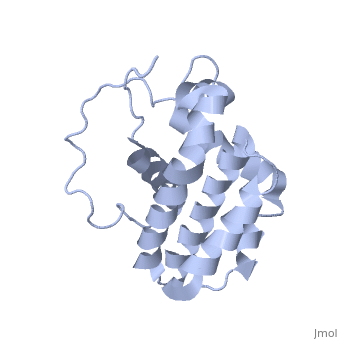Sandbox Reserved 1122
From Proteopedia
(Difference between revisions)
| Line 31: | Line 31: | ||
Bcl-2 localized on external mitochondrial membrane can also inhibit the release of cytochrome c from mitochondria. <ref>[http://science.sciencemag.org/content/275/5303/1132.full The Release of Cytochrome c from Mitochondria: A Primary Site for Bcl-2 Regulation of Apoptosis] </ref> <ref>[http://science.sciencemag.org/content/275/5303/1129.full Prevention of Apoptosis by Bcl-2: Release of Cytochrome c from Mitochondria Blocked] </ref> | Bcl-2 localized on external mitochondrial membrane can also inhibit the release of cytochrome c from mitochondria. <ref>[http://science.sciencemag.org/content/275/5303/1132.full The Release of Cytochrome c from Mitochondria: A Primary Site for Bcl-2 Regulation of Apoptosis] </ref> <ref>[http://science.sciencemag.org/content/275/5303/1129.full Prevention of Apoptosis by Bcl-2: Release of Cytochrome c from Mitochondria Blocked] </ref> | ||
| + | |||
| + | === Regulation of proinflammatory caspase-1 activation === | ||
| + | |||
| + | NALP1 is a member of a NLR-family proteins. Its function is to activate the members of the proinflammatory caspase family which participate in cytokines activation pathway (especially caspase-1). The Bcl-2 loop regions between the BH3 and BH4 bind NALP1. This interaction is exclusively reserved to two members of Bcl-2 family: Bcl-XL and Bcl-2 itself because this interacting region is highly variable in Bcl-2 family. By binding to NALP1, Bcl-2 inhibits the inflammatory caspase activation. Hence, it protects cell from the stress. | ||
| + | The posttranslational modifications found on the loops between BH3 and BH4 modify the anti-apoptotic activity of Bcl-2. Hence, the Bcl-2 binding to NALP1 can be affected by these modifications. <ref>[http://www.sciencedirect.com/science/article/pii/S0092867407003042 Bcl-2 and Bcl-XL Regulate Proinflammatory Caspase-1 Activation by Interaction with NALP1] </ref> | ||
== Disease == | == Disease == | ||
Revision as of 16:23, 28 January 2016
| This Sandbox is Reserved from 15/12/2015, through 15/06/2016 for use in the course "Structural Biology" taught by Bruno Kieffer at the University of Strasbourg, ESBS. This reservation includes Sandbox Reserved 1120 through Sandbox Reserved 1159. |
To get started:
More help: Help:Editing |
HUMAN BCL-2, ISOFORM1
| |||||||||||
References
- ↑ Hanson, R. M., Prilusky, J., Renjian, Z., Nakane, T. and Sussman, J. L. (2013), JSmol and the Next-Generation Web-Based Representation of 3D Molecular Structure as Applied to Proteopedia. Isr. J. Chem., 53:207-216. doi:http://dx.doi.org/10.1002/ijch.201300024
- ↑ Herraez A. Biomolecules in the computer: Jmol to the rescue. Biochem Mol Biol Educ. 2006 Jul;34(4):255-61. doi: 10.1002/bmb.2006.494034042644. PMID:21638687 doi:10.1002/bmb.2006.494034042644
- ↑ Solution structure of the antiapoptotic protein bcl-2
- ↑ Alpha-Helical Destabilization of the Bcl-2-BH4-Domain Peptide Abolishes Its Ability to Inhibit the IP3 Receptor
- ↑ Control of mitochondrial apoptosis by the Bcl-2 family
- ↑ Differential Targeting of Prosurvival Bcl-2 Proteins by Their BH3-Only Ligands Allows Complementary Apoptotic Function
- ↑ Distinct BH3 domains either sensitize or activate mitochondrial apoptosis, serving as prototype cancer therapeutics
- ↑ The Release of Cytochrome c from Mitochondria: A Primary Site for Bcl-2 Regulation of Apoptosis
- ↑ Prevention of Apoptosis by Bcl-2: Release of Cytochrome c from Mitochondria Blocked
- ↑ Bcl-2 and Bcl-XL Regulate Proinflammatory Caspase-1 Activation by Interaction with NALP1

